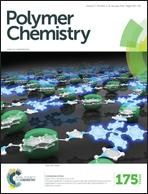Fluorinated bottlebrush polymers based on poly(trifluoroethyl methacrylate): synthesis and characterization†
Abstract
Bottlebrush polymers are densely grafted polymers with long side-chains attached to a linear polymeric backbone. Their unusual structures endow them with a number of unique and potentially useful properties in solution, in thin films, and in bulk. Despite the many studies of bottlebrushes that have been reported, the structure–property relationships for this class of materials are still poorly understood. In this contribution, we report the synthesis and characterization of fluorinated bottlebrush polymers based on poly(2,2,2-trifluoroethyl methacrylate). The synthesis was achieved by atom transfer radical polymerization (ATRP) using an α-bromoisobutyryl bromide functionalized norbornene initiator, followed by ring-opening metathesis polymerization (ROMP) using a third generation Grubbs’ catalyst (G3). Rheological characterization revealed that the bottlebrush polymer backbones remained unentangled as indicated by the lack of a rubbery plateau in the modulus. By tuning the size of the backbone of the bottlebrush polymers, near-spherical and elongated particles representing single brush molecular morphologies were observed in a good solvent as evidenced by TEM imaging, suggesting a semi-flexible nature of their backbones in dilute solutions. Thin films of bottlebrush polymers exhibited noticeably higher static water contact angles as compared to that of the macromonomer reaching the hydrophobic regime, where little differences were observed between each bottlebrush polymer. Further investigation by AFM revealed that the surface of the macromonomer film was relatively smooth; in contrast, the surface of bottlebrush polymers displayed certain degrees of nano-scale roughness (Rq = 0.8–2.4 nm). The enhanced hydrophobicity of these bottlebrushes likely results from the preferential enrichment of the fluorine containing end groups at the periphery of the molecules and the film surface due to the side chain crowding effect. Our results provide key information towards the design of architecturally tailored fluorinated polymers with desirable properties.


 Please wait while we load your content...
Please wait while we load your content...